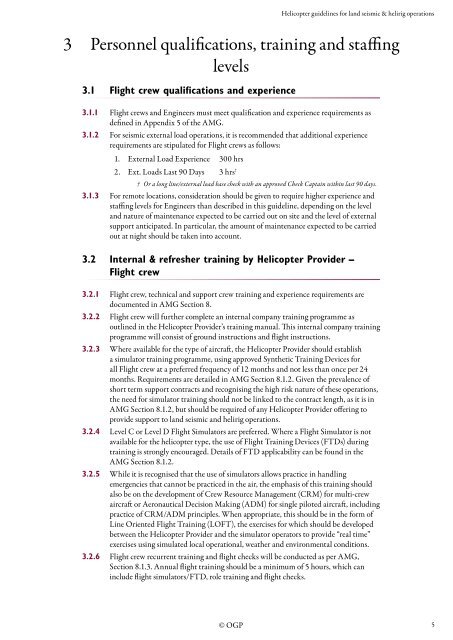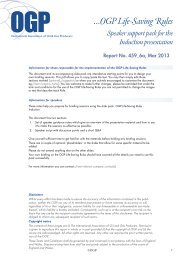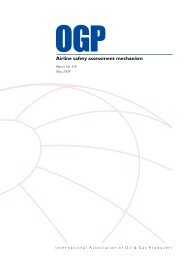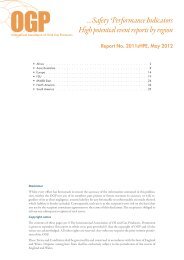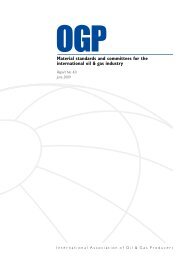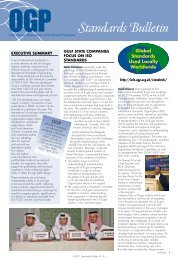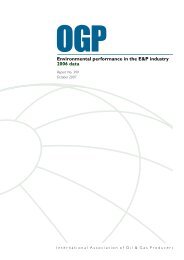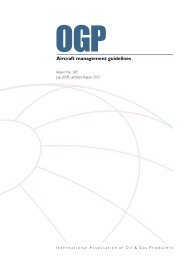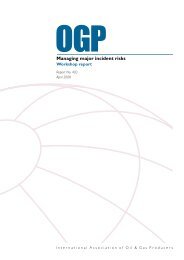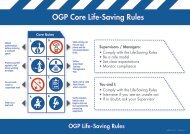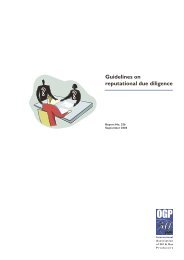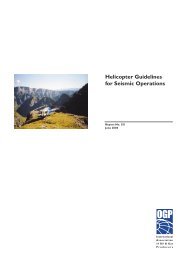Helicopter guidelines for land seismic & helirig operations - OGP
Helicopter guidelines for land seismic & helirig operations - OGP
Helicopter guidelines for land seismic & helirig operations - OGP
Create successful ePaper yourself
Turn your PDF publications into a flip-book with our unique Google optimized e-Paper software.
<strong>Helicopter</strong> <strong>guidelines</strong> <strong>for</strong> <strong>land</strong> <strong>seismic</strong> & <strong>helirig</strong> <strong>operations</strong><br />
3 Personnel qualifications, training and staffing<br />
levels<br />
3.1 Flight crew qualifications and experience<br />
3.1.1 Flight crews and Engineers must meet qualification and experience requirements as<br />
defined in Appendix 5 of the AMG.<br />
3.1.2 For <strong>seismic</strong> external load <strong>operations</strong>, it is recommended that additional experience<br />
requirements are stipulated <strong>for</strong> Flight crews as follows:<br />
1. External Load Experience 300 hrs<br />
2. Ext. Loads Last 90 Days 3 hrs †<br />
† Or a long line/external load base check with an approved Check Captain within last 90 days.<br />
3.1.3 For remote locations, consideration should be given to require higher experience and<br />
staffing levels <strong>for</strong> Engineers than described in this guideline, depending on the level<br />
and nature of maintenance expected to be carried out on site and the level of external<br />
support anticipated. In particular, the amount of maintenance expected to be carried<br />
out at night should be taken into account.<br />
3.2 Internal & refresher training by <strong>Helicopter</strong> Provider –<br />
Flight crew<br />
3.2.1 Flight crew, technical and support crew training and experience requirements are<br />
documented in AMG Section 8.<br />
3.2.2 Flight crew will further complete an internal company training programme as<br />
outlined in the <strong>Helicopter</strong> Provider’s training manual. This internal company training<br />
programme will consist of ground instructions and flight instructions.<br />
3.2.3 Where available <strong>for</strong> the type of aircraft, the <strong>Helicopter</strong> Provider should establish<br />
a simulator training programme, using approved Synthetic Training Devices <strong>for</strong><br />
all Flight crew at a preferred frequency of 12 months and not less than once per 24<br />
months. Requirements are detailed in AMG Section 8.1.2. Given the prevalence of<br />
short term support contracts and recognising the high risk nature of these <strong>operations</strong>,<br />
the need <strong>for</strong> simulator training should not be linked to the contract length, as it is in<br />
AMG Section 8.1.2, but should be required of any <strong>Helicopter</strong> Provider offering to<br />
provide support to <strong>land</strong> <strong>seismic</strong> and <strong>helirig</strong> <strong>operations</strong>.<br />
3.2.4 Level C or Level D Flight Simulators are preferred. Where a Flight Simulator is not<br />
available <strong>for</strong> the helicopter type, the use of Flight Training Devices (FTDs) during<br />
training is strongly encouraged. Details of FTD applicability can be found in the<br />
AMG Section 8.1.2.<br />
3.2.5 While it is recognised that the use of simulators allows practice in handling<br />
emergencies that cannot be practiced in the air, the emphasis of this training should<br />
also be on the development of Crew Resource Management (CRM) <strong>for</strong> multi-crew<br />
aircraft or Aeronautical Decision Making (ADM) <strong>for</strong> single piloted aircraft, including<br />
practice of CRM/ADM principles. When appropriate, this should be in the <strong>for</strong>m of<br />
Line Oriented Flight Training (LOFT), the exercises <strong>for</strong> which should be developed<br />
between the <strong>Helicopter</strong> Provider and the simulator operators to provide “real time”<br />
exercises using simulated local operational, weather and environmental conditions.<br />
3.2.6 Flight crew recurrent training and flight checks will be conducted as per AMG,<br />
Section 8.1.3. Annual flight training should be a minimum of 5 hours, which can<br />
include flight simulators/FTD, role training and flight checks.<br />
© <strong>OGP</strong><br />
5


